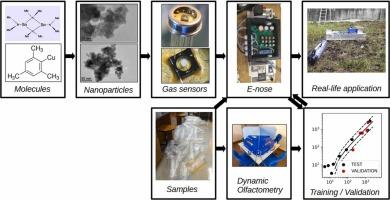用于电子鼻中h2s检测的有机金属衍生金属氧化物传感器,用于气味消减评估
IF 3.7
1区 化学
Q1 CHEMISTRY, ANALYTICAL
引用次数: 0
摘要
我们介绍了基于有机金属和离子交换合成路线的新型金属氧化物气体传感器的开发和应用,并将其集成到电子鼻平台中,用于检测硫化氢(H₂S)和恶臭化合物。采用透射电镜(TEM)、扫描电镜(SEM)、x射线衍射(XRD)和热重分析(TGA)对CuO、SnO₂和WO₃纳米粒子进行了表征。这些纳米材料被沉积成单层和双层结构,形成工程p-n和n-n异质结。在控制湿度和温度的条件下,传感器在宽的h2s浓度范围(5 ppb至50 ppm)内进行了评估。与商用MOS传感器相比,双层结构具有显著增强的灵敏度、选择性和稳定性。将选定的传感器集成到定制的气体传感阵列中,并用于构建电子鼻系统。该系统采用动态嗅觉法进行训练,并应用于某城市固体废物处理厂(MSWTP)实际样品的气味定量。在两个全尺寸生物过滤器中,电子鼻在估计气味浓度和除臭效率方面取得了高精度,优于商业传感器系统。这项研究提出了一个完整的传感器到应用的工作流程,结合了纳米材料设计、传感器工程、统计建模和现实世界的环境监测。它强调了有机金属衍生的MOS传感器作为复杂工业环境中可靠气味检测的先进气体传感平台的关键部件的潜力。本文章由计算机程序翻译,如有差异,请以英文原文为准。

Organometallic-derived metal oxide sensors for H₂S detection in an electronic nose for odor abatement assessment
We present the development and application of novel metal oxide gas sensors derived from organometallic and ion-exchange synthesis routes, integrated into an electronic nose platform for the detection of hydrogen sulfide (H₂S) and odorous compounds. The CuO, SnO₂, and WO₃ nanoparticles were characterized using transmission electron microscopy (TEM), scanning electron microscopy (SEM), X-ray diffraction (XRD), and thermogravimetric analysis (TGA). These nanomaterials were deposited as single and double-layer structures forming engineered p–n and n–n heterojunctions. The sensors were evaluated in a wide H₂S concentration range (5 ppb to 50 ppm) under controlled humidity and temperature conditions. Double-layer configurations exhibited significantly enhanced sensitivity, selectivity, and stability compared to commercial MOS sensors. Selected sensors were integrated into a custom-built gas sensing array and used to construct an e-nose system. The system was trained using dynamic olfactometry and applied for odor quantification in real samples from a Municipal Solid Waste Treatment Plant (MSWTP). The e-nose achieved high accuracy in estimating odor concentrations and deodorization efficiency in two full-scale biofilters, outperforming commercial sensor systems. This study presents a complete sensor-to-application workflow, combining nanomaterial design, sensor engineering, statistical modelling, and real-world environmental monitoring. It highlights the potential of organometallic-derived MOS sensors as key components in advanced gas sensing platforms for reliable odor detection in complex industrial environments.
求助全文
通过发布文献求助,成功后即可免费获取论文全文。
去求助
来源期刊

Sensors and Actuators B: Chemical
工程技术-电化学
CiteScore
14.60
自引率
11.90%
发文量
1776
审稿时长
3.2 months
期刊介绍:
Sensors & Actuators, B: Chemical is an international journal focused on the research and development of chemical transducers. It covers chemical sensors and biosensors, chemical actuators, and analytical microsystems. The journal is interdisciplinary, aiming to publish original works showcasing substantial advancements beyond the current state of the art in these fields, with practical applicability to solving meaningful analytical problems. Review articles are accepted by invitation from an Editor of the journal.
 求助内容:
求助内容: 应助结果提醒方式:
应助结果提醒方式:


